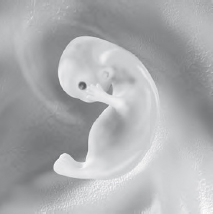Early Modern PhilosophyGottfried Wilhelm Leibniz |
What were Leibniz’s views on embryology? |
Leibniz had a close correspondence with Ernst August’s wife, Sophie, and her daughter, Sophie Charlotte, who became Queen of Prussia. He became president of the Berlin Society of Sciences in the same city where Sophie Charlotte lived. After her death, her family was not welcoming to him (perhaps because they had resented his relationship with her while she was alive).
Leibniz was continually involved in efforts to promote communication and cooperation in scientific research, both theoretical and practical. He also had hopes that all Christians might unite. He was honored with prestigious government posts in Vienna (1712–1714), but by the time of his death his royal patrons, and most of the intellectuals who had known him, abandoned him. They did so for several reasons: Isaac Newton was favored in Leibniz’s dispute with him; Leibniz no longer had the protection of Sophie Charlotte; and his philosophical work was not popular. Neither the Royal Society nor the Berlin Academy saw fit to honor him after he died. King George I was nearby when his funeral was held but did not deign to attend or send a representative.
Leibniz’s grave remained unmarked for almost 50 years, until a descendent of Sophie Charlotte took up the cause of rehabilitating his memory. While it is not clear how damaging his dispute with Isaac Newton (1643–1727) over the discovery of the calculus was to his reputation and standing, it evidently proved more harmful to him than it did to Newton. (Newton had claimed that Leibniz plagiarized his work on the differential calculus.)
When Leibniz died, he was engaged in writing a religious work about Chinese philosophy and the Leibniz-Clark Correspondence in which he attacked virtually every aspect of Newton’s metaphysical system.
Gottfried Leibniz believed in preformationism, the theory that all living things had been created at once so that their offspring unfold from completely formed seeds, or homunculi in the case of humans and animunculi for animals. Some preformationists believed that the whole of successive humanity must have been present in Adam’s testicles from the time he was in the Garden of Eden, while others held that they were in Eve’s ovaries. These two views were called “spermism” and “ovism,” respectively.
The opposing theory to preformationism was epigenesis, or the idea that embryos developed in time. However, before a true knowledge of heredity or conception, together with Christian belief that mere matter could not by itself become a complex living organism, epigenesis did not seem plausible given available evidence.
Antoni van Leeuwenhoek, a highly skilled Dutch lens grinder, was able to construct microscopes that magnified items 200 times. Around 1700, after having seen bacteria, he reported viewing both male and female sperm:
I have often observed the sperm of a healthy man without waiting for it to become corrupt or fluid/watery, five or six minutes after ejaculation. I have noticed a large number of small animals, I think it must be more than a thousand, on an area no larger than a grain of sand.
Leeuwenhoek reported having seen tiny animals with completely formed features in pond scum and tooth plaque, as well as in the sperm of over 30 animals. He was made a member of the Royal Society, and his descriptions of miniature worlds within worlds were accepted as evidence for preformationism, as well as the original creation of everything in the universe, all at once, by God.

